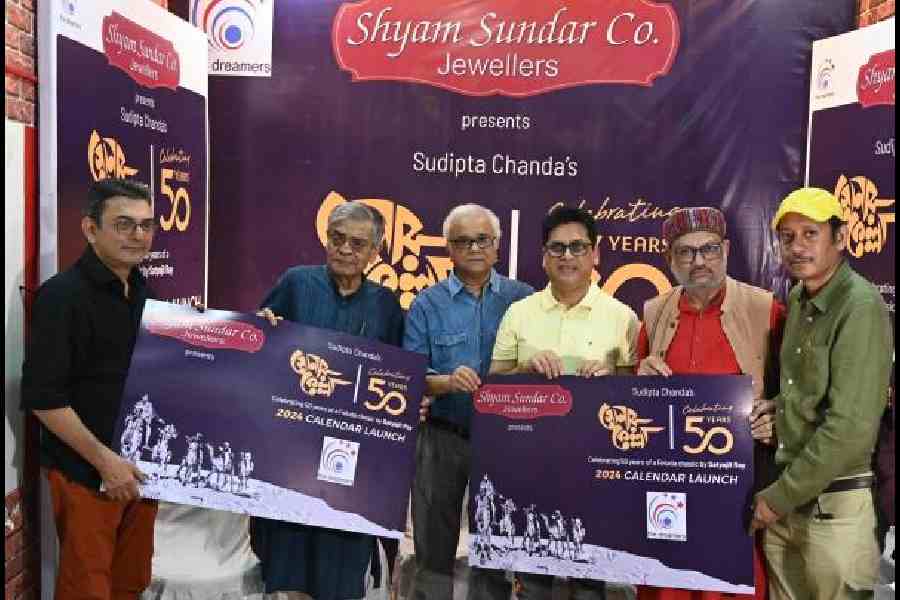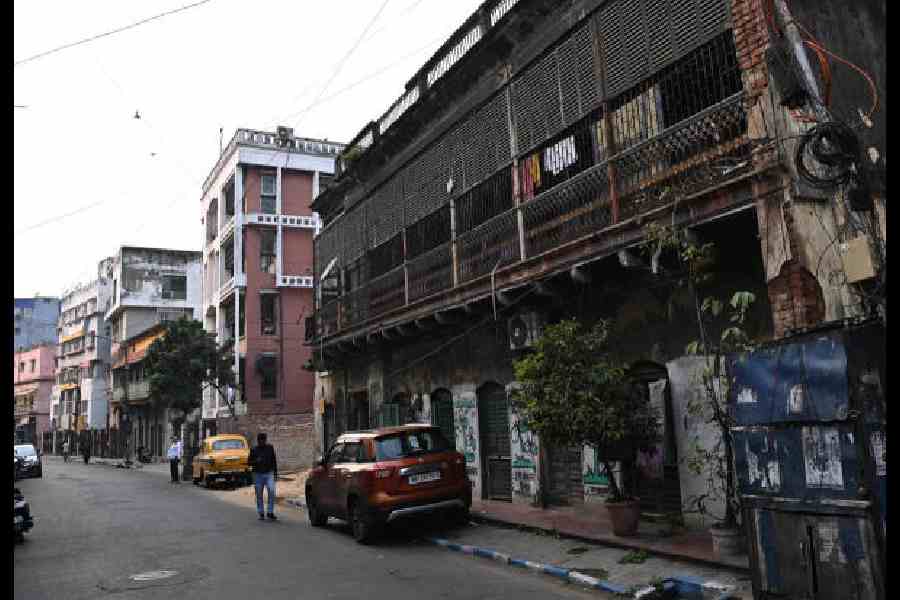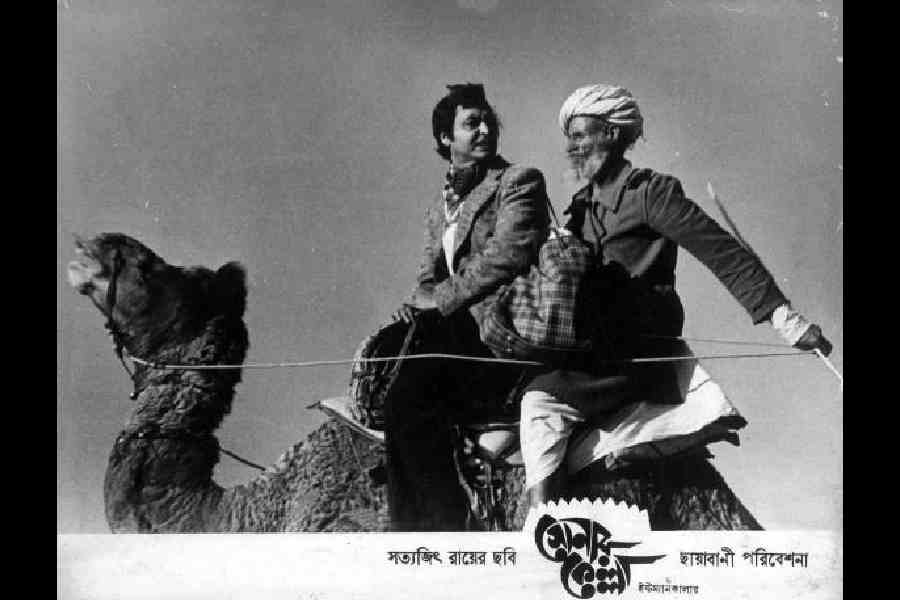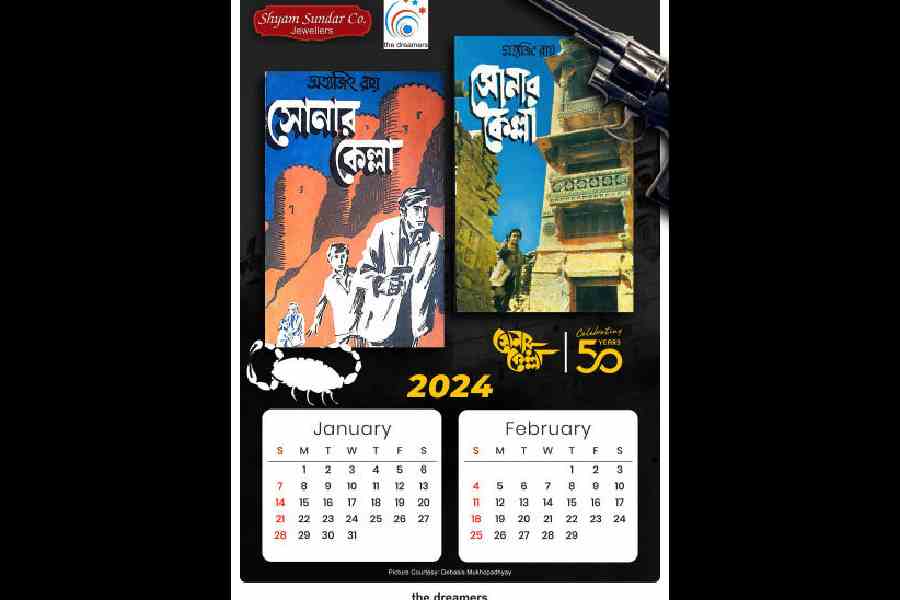A south Calcutta lane in which Mukul was shown to have lived was back in focus on Tuesday when the launch of a special calendar marked the golden jubilee of Satyajit Ray’s immortal film on the golden fort — Sonar Kella.
It also marked the return of Mukul to his para. “Truth be told, I have never shot here. This was where the wrong Mukul was kidnapped,” said Kushal Chakraborty, who had played the role of Mukul as a seven-year-old, on reaching the location.
Indeed a walk down Paddapukur Road shows the area to be caught on the cusp of transition. The building which had been caught in a long shot as the two kidnappers waited in the car, still stands, distinguished by its long ground-floor rowak. This is where the namesake boy Mukul, described by Mukul’s father to the sleuth Feluda as the grandson of lawyer “Shibratan Mukujje” who stayed ”three houses away”, came out of the house and sat momentarily. But the two-storeyed structure is being demolished, condemned by an “unsafe building” notice from the Kolkata Municipal Corporation. It awaits the fate of the next three plots where apartments have come up.

Sandip Ray, Siddhartha Chatterjee, Rupak Saha of Shyam Sundar Co Jewellers, Ray researcher Debashis Mukhopadhyay and organiser Sudipta Chanda launch the calendar on the golden jubilee of Sonar Kella in Mukul's neighbourhood in Paddapukur Road, Bhowanipore, on Tuesday
Standing in the alley where Mukul’s namesake holding a kite had come face to face with the kidnappers, Sandip Ray reflected: “So much has changed in the area!” He and Chakraborty were soon joined by Topshe, Siddhartha Chatterjee.
Seated in the house next to the alley, Chakrabory pointed out that Mukul’s scenes were in Rajasthan. “Only two were shot in Calcutta — one was me sitting up at night and drawing while the other was of a journalist coming home to whom Mukul speaks about the gemstones that trigger all the trouble. Both were shot at Indrapuri Studio, possibly in a single day. My dialogues for those two scenes were written by hand in black fountain pen by Manik jethu (Satyajit Ray) and handed to Baba. He had marked it with an asterisk and added underneath, addressing my father: ‘Rudra, ei duto scene Kushal ke poriye rakhbe kintu ekebarei mukhosto korabe na.’ He had underlined the word ekebarei twice. This was his technique as he knew that if a kid memorised his lines he would not be able to deliver what he was looking for. Such was his astute handling that he got such fabulous performances out of non-actors,” said Chatterjee. He was just over 12 at that time. “He used my natural body language,” he reflected.

A building on Paddapukur Road , Bhowanipore which had been featured in Satyajit Ray’s Sonar Kella as the protagonist Mukul's neighbourhood
The conversation moved to how the film transformed the economy of a place. “Jaisalmer was then a deserted fort. Today, Bengalis visit in droves and Mukul’s house is marked by a signage. The locals don’t know much about Ray. Everything is in Mukul’s name, including a shop. I had met a shopowner called Parekh, who has a photo of his parents with Manik jethu. Old-timers still remember the shoot,” added Chatterjee.
Chakraborty had returned to Jaisalmer in 2016 for another film. “When I reached, there were 20-25 people waiting, with garland, turban and a tray in their hands. Parekh was with them. They wanted to felicitate me. They said they were surviving because of the film. Before the film, Jaisalmer was referred to by people from the rest of Rajasthan as ‘Jaa sale mar’, so desolate it was. To them, Jaisalmer is earth, heaven is the sky and in between is Satyajit Ray, their God.”
The conversation veered towards other cast members who were no more. Both actors agreed that Santosh Dutta might have played a comic character as Lalmohan Ganguly but once his shot was over, he got immersed in his legal documents as a practising lawyer. And it was Kamu Mukherjee, who played the villainous globe-trotter Mandar Bose, who was the livewire on the sets.

A lobbycard of Sonar Kella used in the calendar
Chakraborty recalled that all the cast members got two boiled eggs for breakfast. “He used to take one from me as he knew I would not be able to eat both. A scene was being shot where Mandar Bose would imitate the flailing legs of camels. But by mistake every time he was moving forward while doing the gesture while Manik jethu wanted him to move back. After a few failed takes, jethu went and punched him in the stomach, exclaiming: ‘Will you move forward or backward after being kicked by a camel?’ This time, the shot went well. At lunch break, I saw him sitting morosely and thought he was still upset at being berated. But when I asked, he said the half-boiled egg he had taken from me he had kept in the pocket of the leather jacket that Mandar Bose wore all the time. Jethu’s punch had landed right on the pocket. ‘I was looking forward to eating it now,’ he complained, pointing to the soiled pocket. This was Kamu Mukherjee!”
Sandip Ray, who had accompanied his father all through the shoot, spoke of the planning that went behind the outdoor schedule so far away in the days of telegram and long-distance calls. It lasted a month and half with 60-65 people, he pointed out.
Chakraborty remembered travelling from Delhi to Jaipur and onwards to Jodhpur. “There was no train after Jodhpur. It was all by road to Bikaner and then Jaisalmer, which didn’t even have proper hotels. It fascinates me to reflect on how he pulled it off,” said the grown-up Mukul.
Ray had prepared an elaborate hand-written shooting schedule on a chart paper which took up an entire wall. “I think he would put it up wherever we went. It had every detail in a variety of ink shades — who would come by which train, get off where, put up in which hotel, where the shoot of the day would be held...,” Chakraborty said, adding that the making of the film was as incredible as the film itself.
The train chase sequence on camels also came up. In the first take, the train drivers got so engrossed in watching the shoot that they forgot to feed the boilers for the black steam to emerge. The next time, though the steam billowed perfectly, on seeing Feluda wave the handkerchief and shout ‘roko, roko’, they stopped the train. “Daylight was fading. Thankfully, the third take went off fine,” said Chatterjee, adding how difficult it was to suppress the discomfort of riding the camel. “Only Santosh Dutta could be his natural self as the nervous Jatayu.”
Sandip Ray recalled another critical point when the scene after the camel ride was to be shot just before the trio reached Ramdeora station. “We reached the spot, quite far from Jaisalmer, by noon. The rehearsals went off fine. Baba wanted to shoot silhouettes against the setting sun. So he asked cinematographer Soumendu Roy to indicate when he wanted to roll the camera. The clapstick was given but the camera would not roll. Yet so expert was the crew that (Roy’s assistant) Purnendu Bose managed to fix it right in time for the shot to be canned before the sun set. Otherwise the whole schedule would have fallen through.”
Even then, there was a delay and for the final sequence at Sonar Kella, there were just three hours in hand to take 75 shots. “We had given up. Baba stopped looking at his kheror khata and simply ordered the camera to be placed at spots and get rolling, ignoring comments from assistants. It was all chalked out in his head,” said Ray.

Kushal Chakraborty, who played the child Mukul in Sonar Kella
Even then, at the edit table it was found that a scene was needed — of Mukul weeping on realising he was in the clutches of bad guys — before he smiles at the end. “Manik jethu asked if I could pull it off. Rs 20,000 was to be spent on the set just for that. I responded with confidence. At that age, I felt no pressure,” Chakraborty laughed.
The calendar launch took place at the house of Ratul Krishna Banerjee, who had seen the shoot as a fresh graduate. Ray researcher Debasis Mukhopadhyay shared interesting trivia on the film. “We have seen Sonar Kella before in the Goopi Bagha films. Ray had reconnoitred in Rajasthan in search of the Halla king’s palace and it was the Jaisalmer fort where Goopi and Bagha were imprisoned,” he said.
“Sonar Kella has kept Bengalis in thrall and its golden jubilee deserves to be celebrated. I envisioned the cast coming back here as the homecoming of Mukul after 50 years rather than at any other venue,” said Sudipta Chanda of The Dreamers, a film lover who has earlier brought out calendars on Amitabh Bachchan, RD Burman, Uttam Kumar, Soumitra Chatterjee, Dev Anand, Satyajit Ray and the Sandesh covers.
Sudeshna Banerjee











